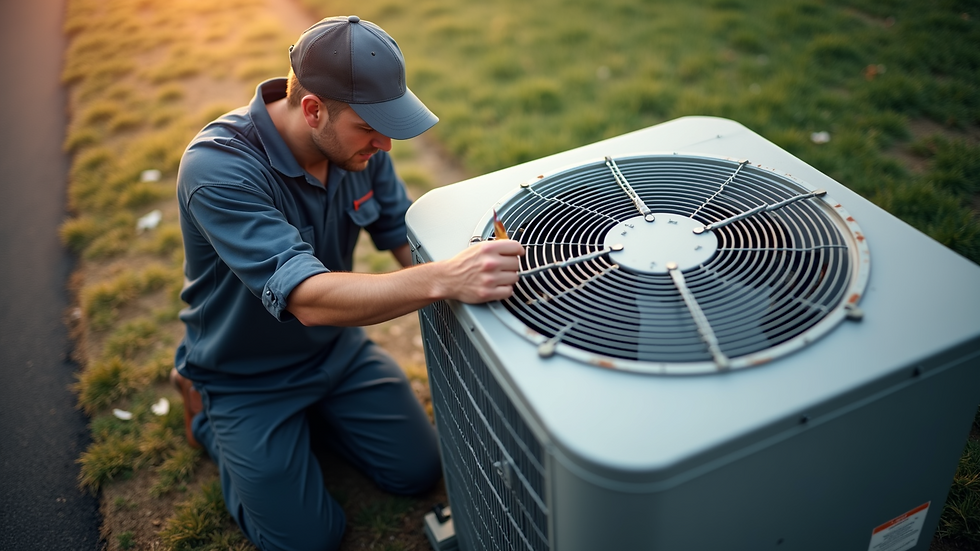How Air Conditioning Systems Work
- Luke Barbosa
- Sep 22
- 4 min read
Air conditioning systems have become an essential part of modern living, providing comfort during hot weather by cooling indoor spaces. But how exactly do these systems work? This article will break down the fundamentals of air conditioning, explaining the key components and processes involved. Whether you're curious about how your home stays cool or considering an upgrade, this guide will provide clear, practical insights.
Air Conditioning Basics: The Core Components and Functions
At its core, an air conditioning system works by removing heat from the indoor air and transferring it outside, creating a cooler indoor environment. The process involves several key components:
Compressor: This is the heart of the system. It compresses refrigerant gas, raising its pressure and temperature.
Condenser Coil: Located outside, this coil releases the heat absorbed from inside to the outside air.
Expansion Valve: This valve controls the flow of refrigerant into the evaporator coil, reducing its pressure and temperature.
Evaporator Coil: Found inside the home, this coil absorbs heat from the indoor air, cooling it.
Blower Fan: Circulates the cooled air throughout the indoor space.
The refrigerant plays a crucial role by cycling through these components, changing from gas to liquid and back, absorbing and releasing heat in the process.

Close-up view of an air conditioning compressor unit showing the metal casing and pipes.
How the Cooling Cycle Works Step-by-Step
Understanding the cooling cycle helps clarify how air conditioning systems maintain comfortable temperatures:
Compression: The compressor compresses the refrigerant gas, turning it into a high-pressure, high-temperature gas.
Condensation: The hot gas moves to the condenser coil outside, where it releases heat to the outside air and condenses into a high-pressure liquid.
Expansion: The liquid refrigerant passes through the expansion valve, which lowers its pressure and temperature.
Evaporation: The cold refrigerant flows through the evaporator coil inside, absorbing heat from the indoor air and evaporating back into a gas.
Air Circulation: The blower fan pushes the cooled air through ducts into the rooms.
This cycle repeats continuously while the system is running, maintaining a steady indoor temperature.

Eye-level view of an evaporator coil inside an air conditioning system showing the metal fins and tubing.
What is the $5000 Rule for AC?
The $5000 rule is a practical guideline used by homeowners and professionals to estimate when it might be more cost-effective to replace an old air conditioning system rather than repair it. The rule suggests that if the cost of repairs approaches or exceeds $5000, it is often better to invest in a new system.
Why $5000? This figure typically covers the cost of major repairs, such as replacing compressors or coils, which can be expensive. Additionally, older systems tend to be less energy-efficient, leading to higher utility bills. A new system can offer improved efficiency, better performance, and potentially lower maintenance costs.
Here are some factors to consider when applying the $5000 rule:
Age of the system: Systems older than 10-15 years may be less efficient.
Frequency of repairs: Multiple repairs in a short time can add up.
Energy costs: Newer models often use less electricity.
Comfort needs: Upgrading can improve air quality and temperature control.
Using this rule can help you make informed decisions about maintaining or upgrading your cooling system.
Maintenance Tips to Keep Your Air Conditioning System Efficient
Proper maintenance is key to ensuring your air conditioning system runs efficiently and lasts longer. Here are some actionable tips:
Change or clean filters regularly: Dirty filters reduce airflow and efficiency.
Keep the outdoor unit clear: Remove debris, leaves, and dirt around the condenser coil.
Check refrigerant levels: Low refrigerant can cause poor cooling and damage the compressor.
Inspect ductwork: Leaks in ducts can waste cooled air and increase energy costs.
Schedule professional tune-ups: Annual inspections by a qualified technician can catch issues early.
Regular maintenance not only improves performance but also helps avoid costly repairs and extends the life of your system.

High angle view of a technician performing maintenance on an outdoor air conditioning unit.
Choosing the Right Air Conditioning System for Your Home
Selecting the right air conditioning system depends on several factors, including the size of your home, climate, and budget. Here are some common types:
Central Air Conditioning: Ideal for cooling entire homes with ductwork. Offers consistent temperature control.
Ductless Mini-Split Systems: Great for homes without ducts or for cooling specific rooms.
Window Units: Affordable and easy to install for single rooms.
Portable AC Units: Flexible but less efficient for large spaces.
When choosing a system, consider:
Energy efficiency ratings (SEER): Higher ratings mean better efficiency.
Capacity: Measured in BTUs, it should match your home's cooling needs.
Installation costs: Include both equipment and labor.
Maintenance requirements: Some systems require more upkeep than others.
For expert advice and professional installation, consider contacting a trusted air conditioning service provider.
Enhancing Comfort Beyond Cooling
Modern air conditioning systems offer more than just cooling. Many include features that improve indoor air quality and comfort:
Humidity control: Some systems can reduce indoor humidity, making the air feel cooler.
Air filtration: Advanced filters can remove dust, allergens, and pollutants.
Smart thermostats: Allow precise temperature control and energy savings.
Zoning systems: Enable different temperatures in different rooms.
Incorporating these features can create a healthier and more comfortable living environment.
Understanding how air conditioning systems work empowers you to make better decisions about maintenance, repairs, and upgrades. Whether you want to improve efficiency, save on energy bills, or enhance comfort, knowing the basics is the first step. For professional support and quality service, reach out to a reliable air conditioning company to ensure your system operates at its best.




Comments